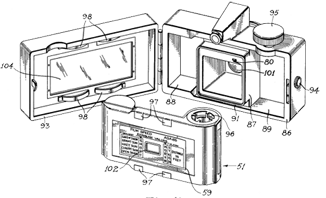|
Argus Lady Carefree |
Manufactured or assembled in Germany from (Circa) 1967 to (After) 1967.
Index of rarity in France: Rare (among non-specialized garage sales)
Inventory number: 4100
See the complete technical specifications
Chronology of cameras Argus
This Lady Carefree was manufactured in Germany by Balda. There is another model with the same name, but of Japanese origin.
This camera is low-end, similar to the simplest Kodak Instamatics. At the time of its distribution, Argus no longer handled any manufacturing and simply marketed third-party cameras.
There are no settings, everything is made of plastic. However, there is a real hinge for the back, not just a thinning of the back like on some Instamatics.
With its rectangular elements surrounded by lines, 'embroidered' 1 patterns, contrasting writings, and shades of beige, ochre, and gold, the camera is aesthetically quite successful. Its 'feminine' appearance is in line with its name.
1 Embroidered' refers to plastic moldings.

Balda followed Kodak in the path of the 126 and released a whole range of cameras using the new film cartridge.
Film and 126 Camera
 The patent 3,138,081 was published on June 23, 1964. It was filed by Kodak, and the inventor's name is Hubert Nerwin.
The patent 3,138,081 was published on June 23, 1964. It was filed by Kodak, and the inventor's name is Hubert Nerwin.
It involves a 35mm film contained within a closed cassette. Asymmetric, it serves both as a supply spool and a take-up spool. There is no possibility of inserting the film the wrong way in the camera due to its design. The film is perforated on one side only. The back is lined with paper bearing a frame number, employing the principle of an unexposed back on cameras to avoid the need for a mechanical frame counter. The camera only requires one drive spindle since there's no need to rewind the film. The cassette is returned to the Kodak laboratory after the final exposure without any additional handling.
With this innovative system, the photographer no longer runs the risk of mispositioning the film start tab or tearing the perforations. Also known as Kodapak, the 126 film was available in 20, later in 24 exposures (the 12-exposure version existed for a short time), either in color negative or for colour slides.

 The shape of the cameras changed during the series' existence. The shutter release of the early models is integrated into the front face and is black (Design 1).
The shape of the cameras changed during the series' existence. The shutter release of the early models is integrated into the front face and is black (Design 1).Later, it is larger and forms the top and left edge of the front face (Design 2).
The most advanced models change in design. The lens is retractable (Design 3). The mechanism for the movement of the lens was the subject of several patents filed in 1971 by Balda. The inventor was Karl-Heinz Lange (US3709129 and DE2136183).
| Years | Lens | Shutter | Design | Misc. | ||
| Models using Flashcube | ||||||
| 104 |  |
c.1968 | Fixfocus | Single speed | 1 | Winding knob. No setup. Fake cell |
| 304 | c. 1968 | Fixfocus | 1/60 | 1 | Like 104, but automatic exposure | |
| 504 electronic |  |
c. 1968 | Fixfocus | 18 to 1/250 | 1 | CdS cell |
| 544 electronic | c.1972 | Fixfocus | 1 | |||
| 644 electronic | c.1972 | Symbols | 1 (?) | |||
| 144 |  |
c.1971-77 | Fixfocus | Single speed | 2 | Winding knob. No setup |
| 344 | c.1972 | Fixfocus | 2 | Like 144, but automatic exposure | ||
| 844 electronic | 1971-77 | 18 to 1/300 | 3 | CdS cell, Light signals in the viewfinder. Retractable lens | ||
| Models using Magicube | ||||||
| 144-X |  |
1971-77 | Fixfocus | Single speed | 2 | Winding knob. No setup |
| 344-X | c. 1972 | Fixfocus | 2 | Like 144-X, but automatic exposure | ||
| 824-X | c. 1974-77 | 1/40 and 1/125 | 3 | Collimated viewfinder. Retractable lens | ||
| 834-X | c.1974-77 | 3 | Lights in the viewfinder indicating the setting (sun, shade, or flash). Retractable lens | |||
| 844-X electronic | c.1972-77 | 18 to 1/300 | 3 | CdS cell, Light signals in the viewfinder. Retractable lens | ||
| 944-X electronic | c.1974-77 | Isconar 5.6/35 Fixfocus | 8 to 1/1000 | 3 | CdS cell. Retractable lens | |
Interesting links or bibliography :
| Histoire de la compagnie Argus, suggested by Jacques Bratieres |
Add a link or element of bibliography, a picture taken with this camera, a picture of box or an ads about this camera
Your photos taken with the same camera:
Cameras from Ebay France (Argus) (Uploaded each 3 hours)







